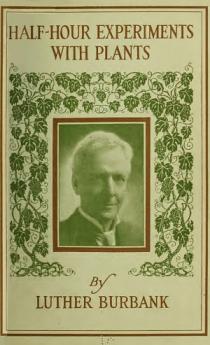Half-Hour Experiments with Plants
About this ebook
Luther Burbank was probably America's most famous botanist, horticulturist and pioneer in agricultural science. He developed more than 800 strains and varieties of plants over his lifetime. Burbank's varied creations included fruits, flowers, grains, grasses, and vegetables. He developed a spineless cactus (useful for cattle-feed) and the plumcot.
This booklet was probably produced by the publisher of his multi-volume masterpiece on plants and his specific gardening techniques as a way to sell a less expensive 'teaser' book to entice serious gardeners to buy his more expensive titles. It briefly details some of his famous plant inventions, and his background. It mostly covers his core experimental techniques for hand-pollenization and grafting that enabled him to do the hundreds and hundreds of experiments that led to his numerous plant discoveries.
Burbank's most successful strains and varieties include the Shasta daisy, the fire poppy (note possible confusion with the California wildflower, Papaver californicum, which is also called a fire poppy), the "July Elberta" peach, the "Santa Rosa" plum, the "Flaming Gold" nectarine, the "Wickson" plum (named after agronomist Edward J. Wickson), the freestone peach, and the white blackberry. A natural genetic variant of the Burbank potato with russet-colored skin later became known as the Russet Burbank potato. This large, brown-skinned, white-fleshed potato has become the world's predominant potato in food processing.
Student's of Burbank and his methods would be wise to also examine the other books he wrote and co-wrote, on his methods and results, including his eight-volume How Plants Are Trained to Work for Man (1921), Harvest of the Years (with Wilbur Hall, 1927), Partner of Nature (1939), and the 12-volume Luther Burbank: His Methods and Discoveries and Their Practical Application.
About the author
Born in Lancaster, Massachusetts, Burbank grew up on a farm and received only an elementary school education. The thirteenth of eighteen children, he enjoyed the plants in his mother's large garden. His father died when he was 21 years old, and Burbank used his inheritance to buy a 17-acre (69,000 m²) plot of land near Lunenburg center. There, he developed the Burbank potato. Burbank sold the rights to the Burbank potato for $150 and used the money to travel to Santa Rosa, California, in 1875. Later, a natural sport of Burbank potato with russetted skin was selected and named Russet Burbank potato. Today, the Russet Burbank potato is the most widely cultivated potato in the United States. A large percentage of McDonald's french fries are made from this cultivar.
In Santa Rosa, Burbank purchased a 4-acre (16,000 m2) plot of land, and established a greenhouse, nursery, and experimental fields that he used to conduct crossbreeding experiments on plants, inspired by Charles Darwin's The Variation of Animals and Plants under Domestication. (This site is now open to the public as a city park, Luther Burbank Home and Gardens.) Later he purchased an 18-acre (7.3 ha) plot of land in the nearby town of Sebastopol, called Gold Ridge Farm.
From 1904 through 1909, Burbank received several grants from the Carnegie Institution to support his ongoing research on hybridization.
Burbank became known through his plant catalogs, the most famous being 1893's "New Creations in Fruits and Flowers," and through the word of mouth of satisfied customers, as well as press reports that kept him in the news throughout the first decade of the century.






